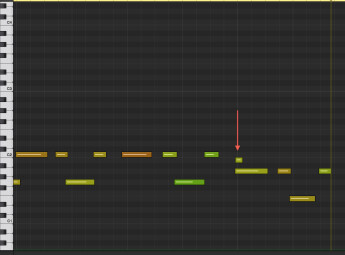If you're a recording musician who doesn't play bass, creating realistic MIDI bass guitar parts can be a challenge. The tips and techniques offered in this article will help you put together authentic sounding tracks.
The sound
Finding a good sounding sampled electric bass is critical to making your part realistic. You want a sampled bass instrument that responds to dynamics, giving you variations depending on how hard you hit the now. You also want to use an appropriate bass sample for the style your song is in.
The most common playing style for electric bass is with the fingers on the right hand, which is referred to as a “fingered bass.” This has the roundest and smoothest tone.
Here’s a little 5-measure bass part with a fingered bass sound, the Scarbee MM-Bass for Native Instruments Kontakt.

A bass played with a pick is brighter, has a harder attack, and tends to be a bit thinner. It’s generally a matter of taste whether you use a fingered or picked bass instrument.
Here’s the same part with a picked bass sound, Pick Round-Wound P-Bass from IK Multimedia’s SampleTank 3.

Slap bass is more of a specialized sound for funk and certain types of R&B, and should only be used where appropriate musically. Here’s the example with the P-Bass Rich Slap from SampleTank 3.

Fretless bass samples can sound very cool, offering smoothness and glissandos into notes that you can’t get from a sample of a fretted bass. Fretless works well for jazz or pop ballads, but not generally for heavy rock. Here’s the same example again, this time with the Fretless J Bass Solo patch from SampleTank 3.

Most sampled bass instruments that you’ll find are already compressed and EQed, but that doesn’t mean that you can’t add some additional processing. Certain rock bass styles feature distorted bass sounds. For those, you can look for samples of a distorted bass or add your own distortion to a clean bass sample.
The bottom line is to find a sample that’s good sounding, offers a range of dynamics, and is the appropriate kind of bass for the music you’re playing.
Some bass instruments offer additional bass articulations that can be activated with key switches (which are notes below the range of the samples, which trigger slides or mutes, slaps, and pops). Some also offer velocity switches, which activate certain performance articulations (such as a slide up) based on how hard you hit the note.
Even without key or velocity switches, you have some control over articulation by adjusting the length and velocity of notes. Notes that overlap slightly have a more legato attack, whereas notes that don’t have a more stacatto attack. Here’s an example where the first three notes overlap, and the second three don’t. You’ll hear the difference.

Many bass samples were recorded direct. If you want a more “live” sound, you could insert a bass amp modeling plug-in, which will allow you to change the tone quite a bit.
Home on the range
When trying to create a MIDI bass part that sounds authentic, as with any MIDI instrument part, you want to keep within the range of a real bass. If you’re trying to imitate a standard 4-string bass, your lowest possible note will be an E1 and your highest note approximately D3 . Most of your playing will be between E1 and E3.
A 5-string bass can go lower, typically down to B0, which is also the low note on a 6-string bass. However, bear in mind that many bass samples, unless they’re from a 5– or 6-string, might sound a bit odd down that low, because the notes are being transposed beyond where they were intended. You’d face the same issue if you tried to play parts that use the extended upper ranges of a 5– or 6-string bass on a sampled 4-string instrument.
Lock it up
Boiled down to its most fundamental level, the role of the bass is to play notes that support the harmonic (chord) structure of the song, using rhythmic patterns that are locked in with the kick drum. If you listen to a real bassist and drummer playing, you’ll notice how locked the bass and the kick are. That tightness is a big part of what propels a song’s rhythm forward.
In this example, the bass is playing a simple part based on the kick pattern.

The bass doesn’t have to play simultaneously with every beat of the kick, but it shouldn’t emphasize notes that are slightly off from it, or it will sound like a mistake. For instance, if the kick drum is hitting on the downbeat (first beat) of a measure, the bass should be hitting that note as well, not anticipating it by a sixteenth note.
To illustrate that point, here’s another bass and drums example. The first part is locked in with the kick. After a pause it repeats, but this time, the bass anticipates one of the notes by sixteenth note while the kick is right on the beat. You’ll hear how wrong that sounds.

You’ll find that if you’re unsure of a baseline for a particular song, creating a line that hits on some or all of the kick beats will almost always yield a part that works. You can then expand and embellish the part using that as your foundation.
This bass part in this example mainly mimics parts of the kick pattern, with a few fills added for ornamentation. Listen to how tight it feels.

Patterns and transitions
There are all manner of bass line possibilities, and way too many to cover comprehensively in a short article like this. However, I did want to mention a few important ones that will help you with part creation.
Transitioning from one chord to the next. One thing that bassists do a lot of is to “walk” into a note. In other words, to move up or down to the next chord using notes leading into the new chord to get there. In this example the bass goes from a C chord to an F chord and back, using transitional lines to get from one to the other.

I to V (one to five): This is a very common bass pattern that plays a quarter notes that alternate between the root (aka “the I”) of the chord and a fifth below it (“the V”), and gives you a solid rhythm that propels forward.
Here are a couple of examples in different genres.
First, a country pattern.

Now, here’s that same type of I-V pattern with a Latin groove, with which it also works well.

Walking: baselines: For blues, swing and other shuffles, a walking bass is a very high energy pattern that’s great to use through an entire song, or in certain spots (like under a solo instrument) where you want to ratchet up the energy. A walking bass moves in a scalar or chromatic fashion, changing to a different note on virtually every quarter note.
There are some standard walking bass lines, but you can also get creative.
Here’s a chorus of a blues progression with a very simple walking line, which is mostly hitting quarter notes, and using the root, third, and fifth of the chord for its note choices.


Alternating octaves:
Using the root of the chord and the same note up or down an octave, can be another useful technique. When you’re stuck for a good line, try doing an octave-based line that syncs with the kick drum.
Here’s an example.

Editing your parts
If you’re trying to sound like a bassist, rather than a computer, you should try to play in your bass parts on your MIDI keyboard, rather than programming them into your DAW. Once you’ve played in either a full song or a specific section, open it up in your piano roll editor and fix any bad notes you find. It’s easy to accidentally trigger additional notes beyond what you were trying to play, which you’ll see in your editor typically as small notes above or below the desired note. Delete these extraneous notes and durations that don’t sound right (including unintended overlaps).
You’ll probably want to quantize it a bit, to tighten up the rhythm. Avoid over quantizing, however, because even a bass player with excellent time isn’t going to be exactly on the beat most of the time. Use the strength control in your DAW’s quantize section at about 30 to 50%. That will tighten things up but not overly so.
Make sure that the quantize value is set to the shortest note-value in your part — in other words, if you have sixteenth notes in your part, don’t set the quantize value to eighth or quarter notes — or it will alter your rhythm. For more on quantizing, read the article “Quantizing Basics.”
Bass hit
The subject of bass lines and bass programming is a broad one, and we’ve only covered some fundamentals here. But the information provided should be enough to make it easier to create your own MIDI bass guitar parts.


